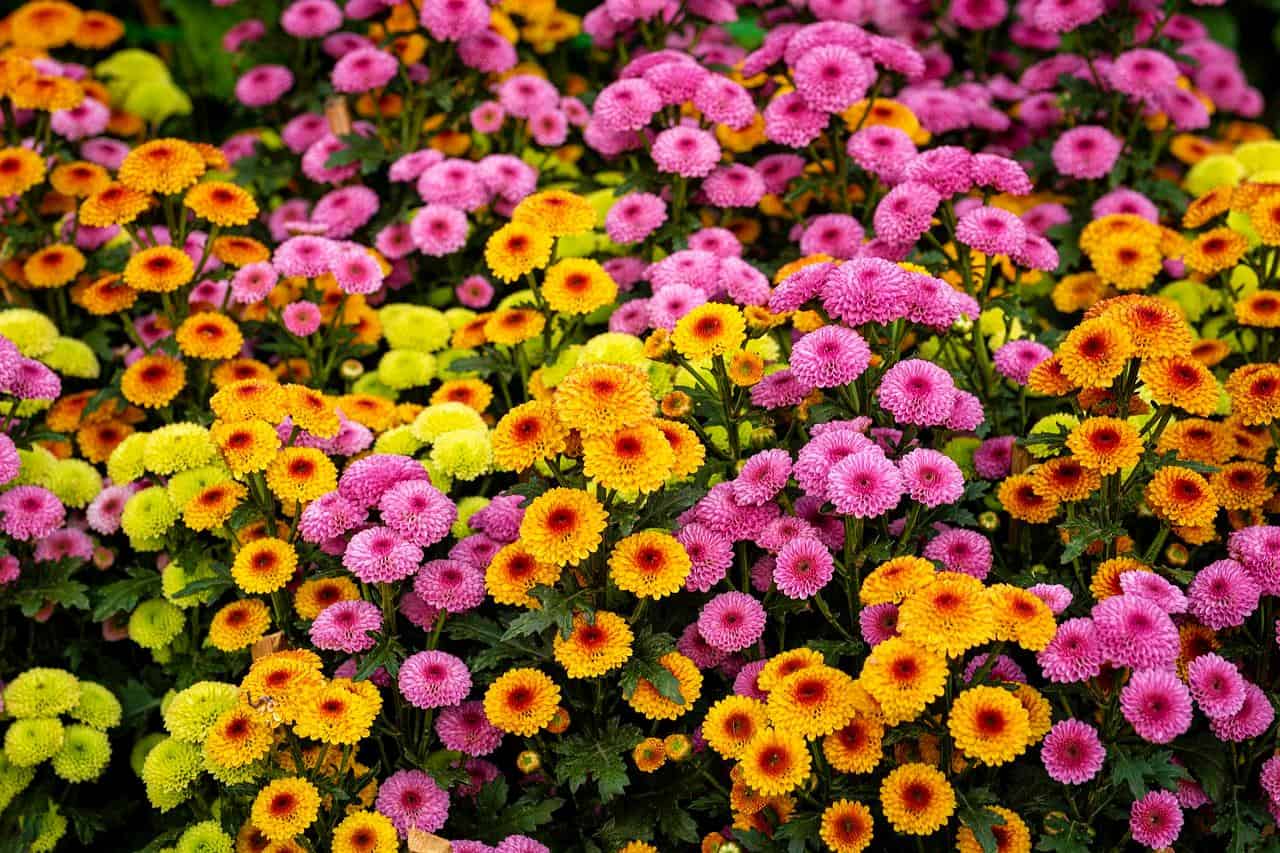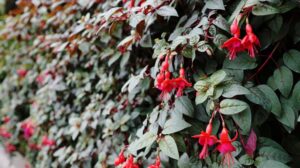In this comprehensive guide, we’ll explore a diverse array of full sun flowers, highlighting their unique characteristics and the magic they can bring to your outdoor spaces.
Agapanthus

Agapanthus, commonly known as the African lily, is a perennial that is a standout performer in sunny gardens. This flower is celebrated for its stunning, spherical clusters of blue or white blossoms that rise on tall, slender stems. The architectural form of Agapanthus adds elegance to any landscape.
Beyond their striking appearance, Agapanthus plants are generally drought-resistant once established, requiring minimal care. They flourish in well-draining soil and have a preference for sunny locations, making them perfect for borders, beds, or even large containers. They bloom during the summer months, typically from May to August, and can attract a variety of pollinators, such as bees.
To ensure optimal growth, incorporate a rich organic amendment into the soil when planting. Dividing established clumps every few years will promote healthy growth and more abundant blooms. Perfectly suited for Mediterranean or coastal gardens, Agapanthus offers a fantastic way to infuse your garden with a splash of azure and ivory.
Allium

Alliums are not only visually captivating, but they also carry an air of intrigue with their unique globular flower heads. These members of the onion family feature large clusters that sit atop tall stems, creating a whimsical, almost architectural effect in the garden. From the majestic Allium giganteum with its striking purple spheres to smaller varieties like Allium moly with cheerful golden blooms, there’s an allium for every space.
Thriving in well-draining soil enriched with organic matter, alliums prefer sunny locations but can tolerate light shade. They are perennial plants that add multi-season interest, as their foliage emerges in spring, and the flowers bloom from mid-spring to early summer. Not only do they attract bees and butterflies, but their long-lasting flower heads also make excellent cut flowers.
After blooming, the allium seed heads can be left in place for added winter interest in the garden, or you can collect them as a delightful and enduring addition to floral arrangements. A smart choice for borders, rock gardens, and even naturalistic settings, alliums are a must-have for gardeners who desire a touch of whimsy.
Angelonia
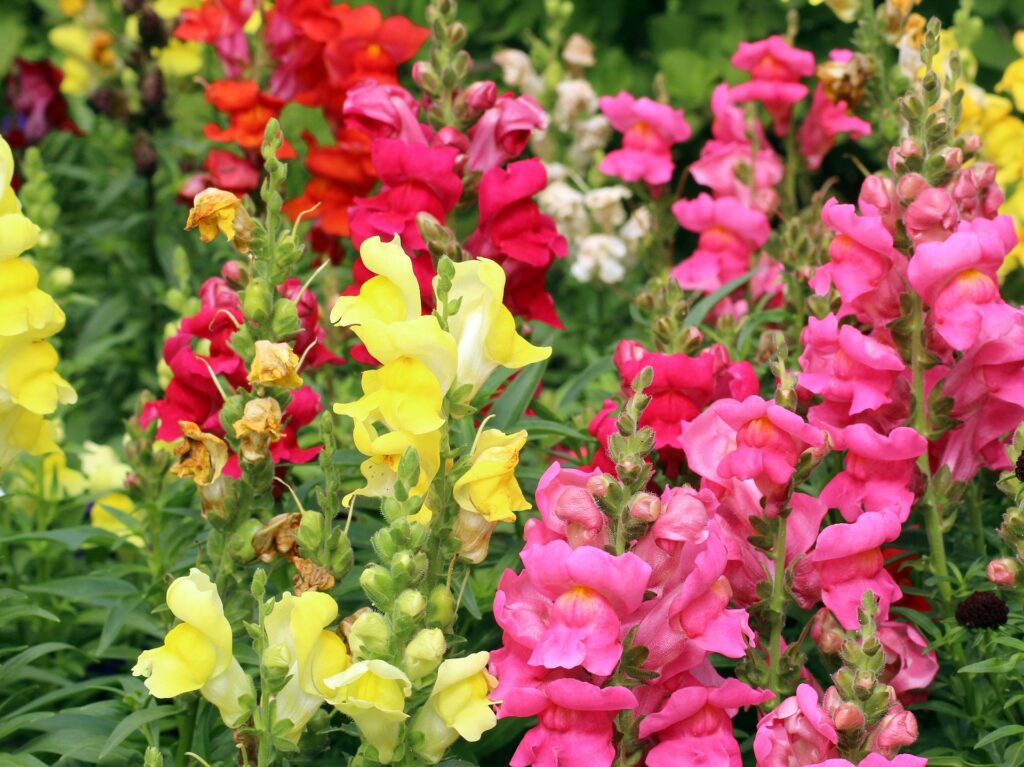
Angelonia, often referred to as summer snapdragon, flourishes in hot, sunny environments, providing a continuous show of colorful spikes. These sturdy annuals are available in an array of shades, including soft pastels and vibrant purples, making them versatile for various garden styles.
This plant’s tolerance to heat and drought makes it an excellent choice for low-maintenance gardens. Angelonia will bloom from late spring until the first frost, creating an ongoing display of beauty. It is especially well-suited for mixed borders, perennial gardens, or containers where its upright growth can add height and structure. They thrive in well-drained soil and prefer regular watering during dry spells to maintain their vibrant appearance.
These flowers also emit a lovely fragrance, making them delightful to have nearby. To keep them blooming profusely, deadheading is encouraged, which will promote further flowering throughout the season. Planting angelonia is a great way to enjoy the warmth of summer while adding effortless style to your garden.
Black-Eyed Susan
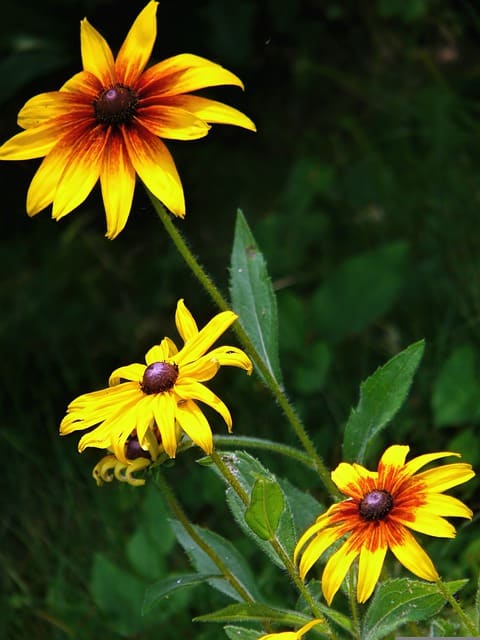
Black-eyed Susans, or Rudbeckia hirta, are iconic flowers that capture the essence of summer with their cheerful yellow petals and dark brown centers. These hardy perennials are resilient and thrive in various soil types, making them easy to grow in sunny locations.
Blooming from mid-summer to early fall, Black-eyed Susans can reach heights of up to three feet, making them a fantastic option for back borders, wildflower gardens, or naturalized areas. They are drought-tolerant once established, requiring minimal care and attention. Additionally, they actively attract pollinators, including bees and butterflies, making them a dynamic addition to any garden.
Deadheading spent blooms encourages extended flowering, while the remaining seed heads provide food for birds, particularly finches, during the winter months. Their bright disposition and adaptability make Black-eyed Susans a favorite in many gardens, bringing a dose of warmth and cheer.
Blanket Flower
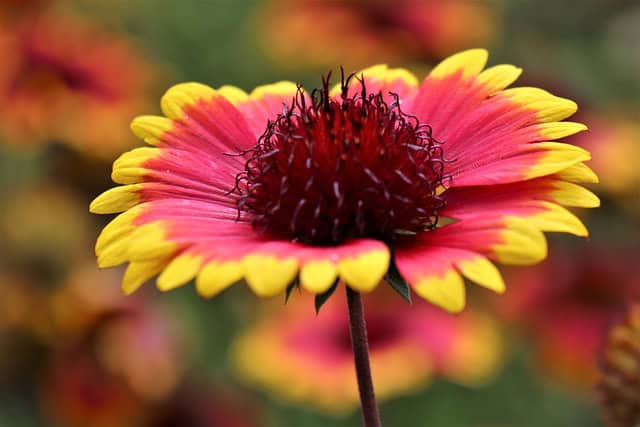
Blanket flowers, or Gaillardia, are known for their vibrant and fiery blooms that glow in shades of red, orange, and yellow. Often resembling a painter’s palette, these flowers create a warmth and vibrancy that can elevate any garden.
Blanket flowers thrive in full sun, well-drained soils, and are remarkably resilient to drought, making them perfect for low-maintenance settings. They bloom from early summer until the first frost, adding continuous color to your landscape. Their long-lasting flowers are also excellent for attracting pollinators and beneficial insects.
In planting, consider using blanket flowers in masses for a bold statement or interspersing them in mixed perennial beds for a more casual effect. These hardy plants may require deadheading to promote additional blooms and can be easily divided every few years, reinforcing their beauty for seasons to come.
Blazing Star
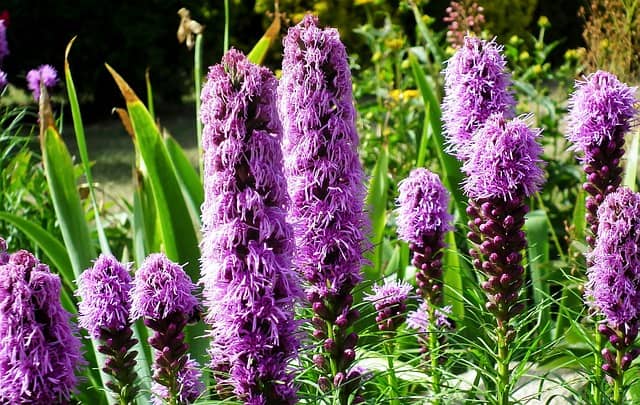
Blazing Star (Liatris spicata) is a charismatic perennial renowned for its exceptional tall spikes adorned with fluffy blooms. Each spike blooms from the top down, creating a unique visual appeal that stands out in sunny garden settings.
The flowers are typically violet-purple but can also be found in white, and they attract butterflies abundantly, making them a valuable asset for pollinator gardens. Blazing Stars flourish in well-drained, sandy soils and are tolerant of drought once established. They bloom from mid-summer to early fall, providing extended interest in the garden.
These flowers are not only beautiful in the landscape but also make striking cut flowers that can last for weeks in floral arrangements. Plant them in groups or drifts to create a stunning vertical accent in borders or meadows. Their resilience and beauty create a perfect combination for gardeners seeking both aesthetics and ecological benefits.
Butterfly Weed

Butterfly Weed (Asclepias tuberosa) is a stunning perennial that attracts a plethora of butterflies, particularly monarchs. Featuring clusters of vibrant orange flowers, this plant offers a bright pop of color in any garden setting and plays an essential role in supporting local ecosystems.
Typically blooming from late spring to early summer, butterfly weed thrives in well-draining soil and full sun. It is drought-tolerant once established, making it an excellent choice for xeriscaping or low-maintenance gardens. This plant requires minimal care, primarily needing deadheading, which will encourage additional blooms during the summer months.
Besides its beauty, butterfly weed is also known for its medicinal properties, historically used to treat various ailments. Its natural appeal, ecological benefits, and low-maintenance nature make it an exceptional choice for attracting butterflies while enriching your garden.
Catmint

Catmint (Nepeta) is a perennial flowering plant valued for its aromatic leaves and lovely spikes of lavender-blue flowers. This sun-loving plant thrives in well-drained soils and produces blooms that attract bees, butterflies, and other beneficial insects, making it an excellent choice for pollinator-friendly gardens.
Catmint is drought-tolerant and can thrive in poor soil conditions, making it a low-maintenance option. Blooming from late spring through early summer, catmint continuously provides color throughout the season, often blooming again in late summer with proper care.
This adaptable plant can be used in borders, as a ground cover, or in rock gardens. Its fragrant foliage can also deter certain pests. Pruning back the plant after the initial blooming period can promote robust second blooms. Catmint brings both beauty and functionality to sunny garden spaces, creating a delightful landscape.
Celosia

Celosia, commonly known as cockscomb or woolflower, is celebrated for its striking and unique blooms that resemble flames or plumes. Available in shades of vibrant red, orange, and pink, celosia adds drama and texture to any garden.
This annual thrives in full sun and prefers well-draining soils with regular watering. Its heat tolerance makes it especially suitable for summer gardens. Celosia blooms continuously from summer until frost and can be used in both borders and containers, where its bright flowers can be showcased as focal points.
As a bonus, celosia performs exceptionally well as a cut flower, lasting for weeks in arrangements and bringing bold color indoors. Its resilience and high visual impact make celosia an attractive choice for both seasoned and novice gardeners looking to make a statement.
Cleome
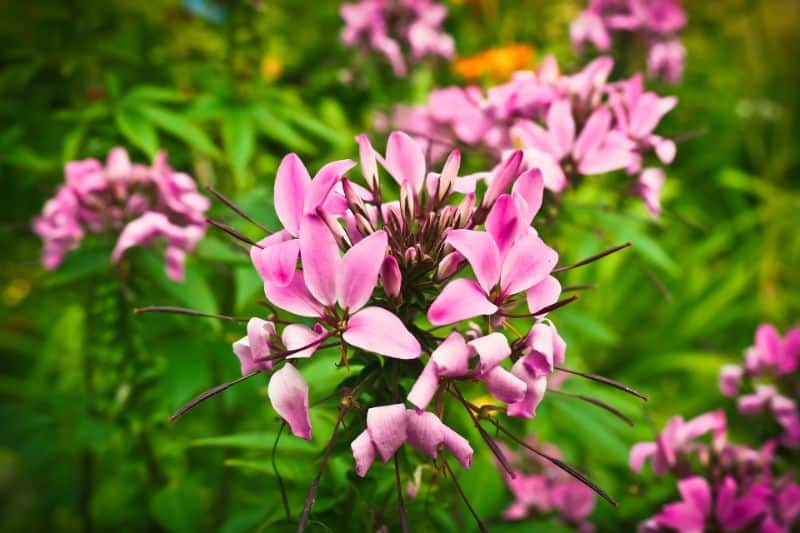
Cleome, often referred to as spider flower, is an eye-catching annual that produces tall spikes of pink, white, or purple flowers. This delightful plant grows swiftly and will flourish in hot, sunny locations, reaching heights of up to 5 feet.
Cleome’s unique flower structure, resembling exotic fireworks, serves to attract all manner of pollinators, particularly bees and butterflies. It thrives in well-drained soil and can tolerate periods of drought once established. Blooming from late spring until first frost, Cleome brings continuous color to the garden.
This impressive annual may reseed itself, ensuring long-lasting beauty in your garden year after year. To promote bushy growth, pinch back the tips of young plants. Planting cleome in groups will create a stunning visual impact, making it a fantastic choice for borders or naturalized areas.
Chrysanthemum
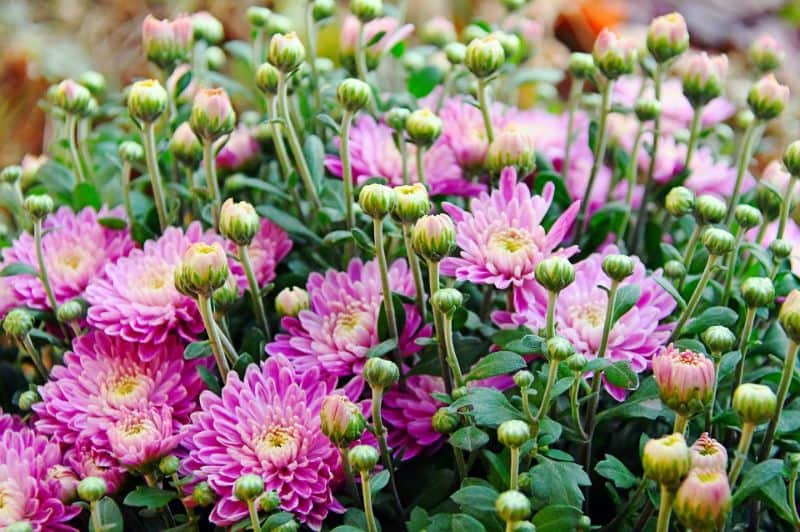
Chrysanthemums, or mums, are classic favorites among gardeners, prized for their variety and versatility. These perennial flowers bloom from late summer to fall, creating stunning displays of color that can range from fiery reds to soft yellows and deep purples.
Mums thrive in full sun and prefer well-drained soil enriched with organic matter. Regular watering, particularly in dry spells, will support their health and allow for impressive blooms. Deadheading spent flowers encourages additional flowering and a longer blooming season.
Chrysanthemums are particularly appealing for fall gardens, providing vibrant colors as many other flowers fade. Additionally, their stunning blooms are perfect for bringing indoors as cut flowers in arrangements. Mums are not only versatile but also pair beautifully with other fall-flowering plants, enhancing the overall ambiance of any garden.
Coneflower
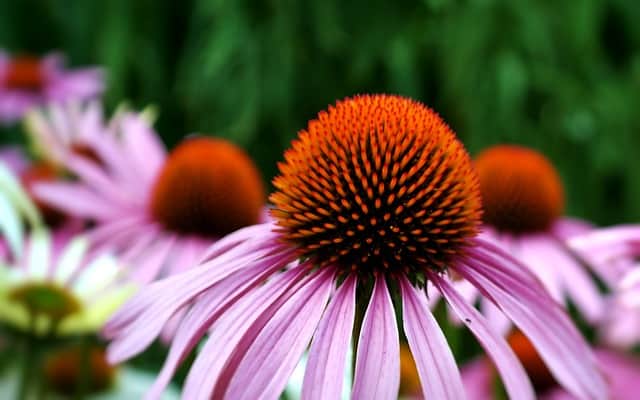
Echinacea, or coneflower, is a beloved perennial characterized by its distinctive daisy-like blooms and prominent seed heads. Coneflowers are available in various colors, including classic purple, pink, and white, and they thrive in sunny spots with well-drained soils.
These hardy plants bloom from summer to early fall, attracting a host of pollinators, including bees and butterflies. Coneflowers are drought-tolerant once established, making them a resilient choice for gardeners seeking low-maintenance options. Besides their beauty, coneflowers are also known for their medicinal uses, historically valued for their immune-boosting properties.
To promote healthy growth and extend blooming, deadheading spent flowers is advised, while allowing attractive seed heads to remain can feed birds during the colder months. Their sturdy structure and vibrant colors make coneflowers an enduring favorite for summer gardens, offering both aesthetic appeal and ecological benefits.
Coreopsis
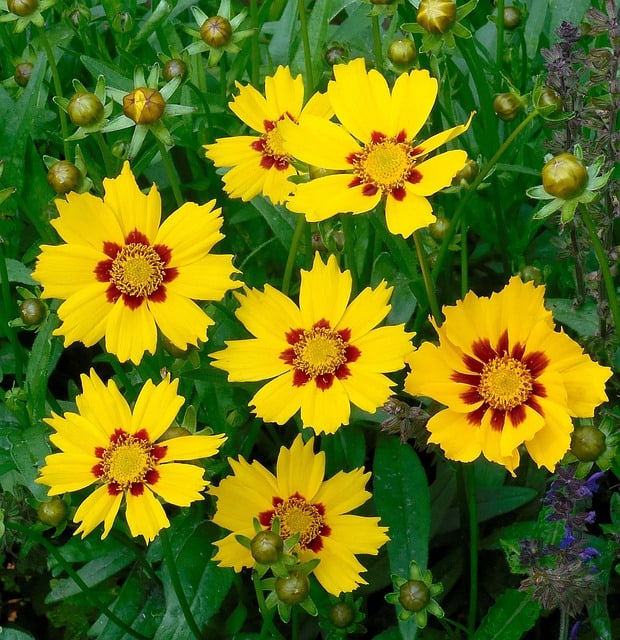
Coreopsis, commonly known as tickseed, is a delightful perennial flower that is sun-loving and easy to grow. With their cheerful, daisy-like blooms in hues of yellow, orange, and red, these flowers brighten any garden space and offer a hint of wildflower charm.
Coreopsis thrives in a variety of soil types, including poor soils, and requires minimal maintenance. Blooming profusely from early summer to fall, coreopsis attracts various pollinators, enhancing the biodiversity of your garden.
This resilient plant tends to self-seed, allowing for a naturalized look if you let it spread. Deadheading will encourage more blooms and prolong the flowering period. Whether planted in large drifts, mixed beds, or borders, coreopsis offers a striking display, making it a favorite among gardeners who enjoy low-maintenance beauty.
Cosmos
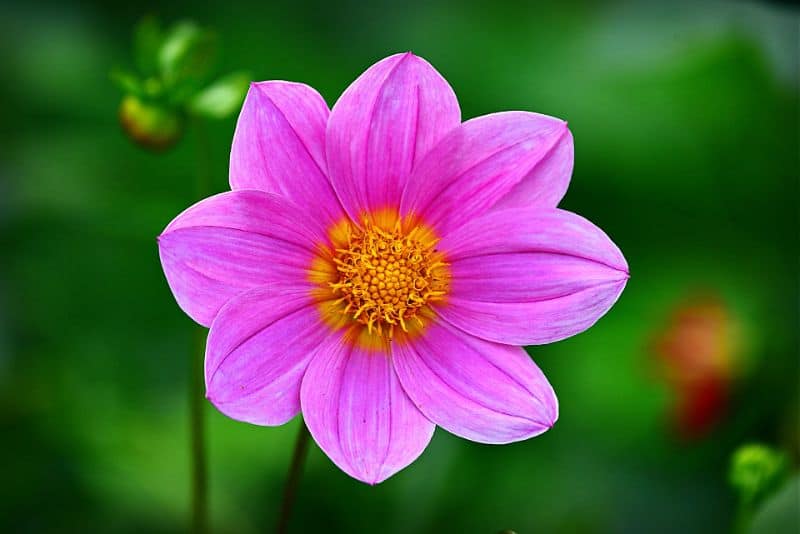
Cosmos are vibrant annual flowers that make a bold statement in full sun gardens. Their large, bushy plants produce colorful blooms in shades of pink, white, and orange, creating a whimsical, airy appearance.
These flowers thrive in well-drained soil and require minimal care, making them perfect for both novice and experienced gardeners. Blooming from mid-summer to fall, cosmos attract pollinators and lend an informal charm to cottage gardens, allowing for abundance even in more wildflower-inspired landscapes.
To promote bushier growth and longer blooming periods, regular deadheading is beneficial. Cosmos are also popular as cut flowers, adding color to bouquets and arrangements. Their graceful presence and ability to tolerate drought make cosmos a staple for those seeking low-maintenance plants that still provide abundant beauty.
Dahlia
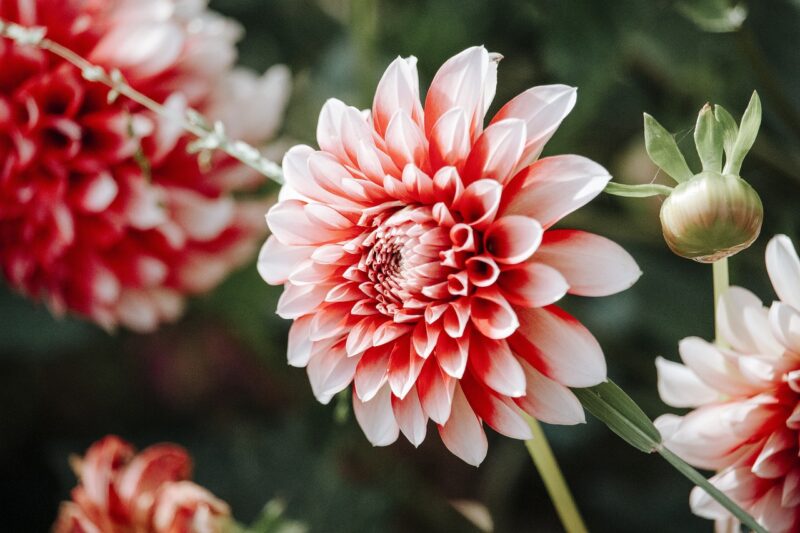
Dahlias are among the most captivating flowers you can grow, known for their breathtaking blooms that come in a variety of colors, shapes, and sizes. From small pom-poms to large dinner plate varieties, dahlias add drama and elegance to any garden.
These tuberous perennials thrive in full sun and require rich, well-drained soil for optimal growth. Established dahlias bloom from mid-summer until the first frost, providing a continuous show of eye-catching flowers. Regular deadheading encourages prolonged blooming, while providing sturdy support for taller varieties is crucial to keep them upright.
Dahlias also make wonderful cut flowers, allowing you to bring their stunning beauty indoors. They require some care during the growing season, including regular watering and fertilization, but the payoff is well worth your effort as they provide substantial visual impact wherever planted.
Daylily
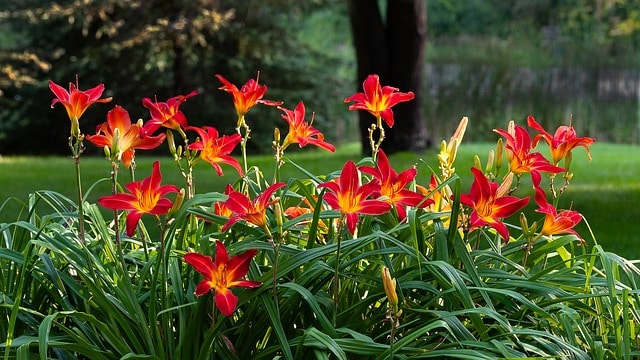
Daylilies are hardy perennials known for their unique blooms that last one day, offering fresh flowers daily throughout their blooming season. Their trumpet-shaped flowers come in a variety of colors and sizes, providing a cheerful display that brightens up any garden.
Thriving in full sun or light shade, daylilies require well-drained soil and are relatively low maintenance once established. They bloom prolifically from late spring to early summer and can provide continuous color through staggered bloom times of different varieties. Their adaptability makes them suitable for garden beds, borders, and even as stunning specimens in mixed gardens.
Daylilies are also great for naturalistic or cottage-style gardens and can effectively handle drought conditions, making them a resilient choice for low-maintenance landscapes. Their strong yet delicate blooms provide visual interest and can attract beneficial insects, enriching the ecosystem of your garden.
Delphinium
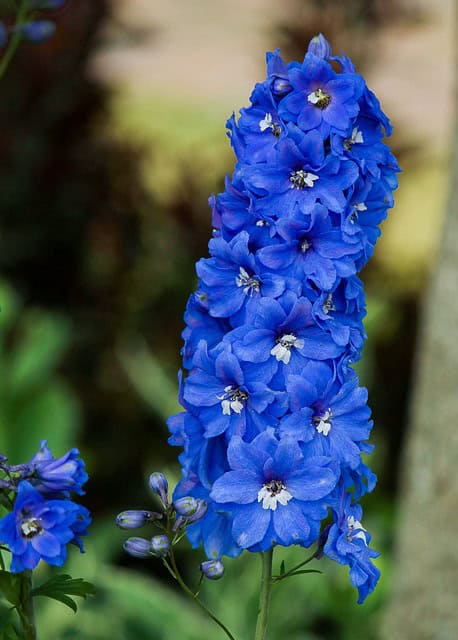
Delphiniums are majestic perennials that create vertical interest and drama in sunny gardens. Known for their tall spikes adorned with exquisite flowers in shades of blue, purple, and white, delphiniums are the epitome of elegance.
They prefer full sun and thrive in well-drained, fertile soil. Regular watering is essential, particularly during dry spells, and support structures like stakes may be necessary to keep their magnificent blooms upright. Delphiniums bloom from early summer through early fall and attract butterflies, making them valuable for pollinator-friendly gardens.
Although they can be a little finicky with pests, their striking beauty far outweighs the extra care needed. Planting delphiniums in groups creates a stunning effect and allows for a grand display in any sunny garden. Their gorgeous blooms also make stunning cut flowers, enhancing arrangements with their regal flair.
Dianthus
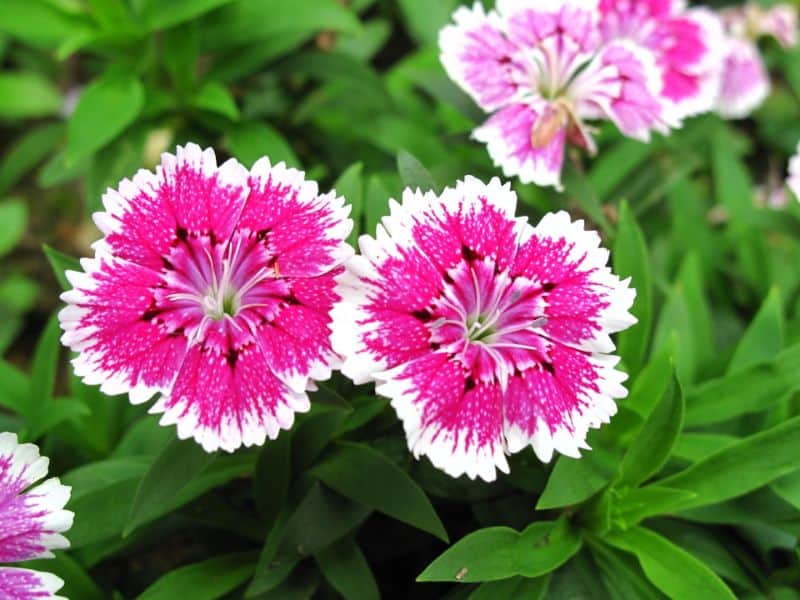
Dianthus, often called pinks, are beloved perennial flowers that thrive in sunny gardens. With their unique, frilled blooms and delightful fragrance, these flowers come in an array of colors, including pinks, reds, and whites.
Dianthus prefers well-drained soils enriched with organic matter and thrives in full sun. They bloom from late spring to early summer, attracting butterflies and providing a romantic touch to any landscape. Their compact growth habit makes them ideal for borders, rock gardens, or containers.
Regular deadheading encourages extended flowering, while allowing some blooms to set seeds can create a naturalized look. Dianthus can also be used as a ground cover in areas where other flowers may struggle. Their sweet scent and cheerful appearance make them a timeless favorite for sunny garden spaces.
Euphorbia
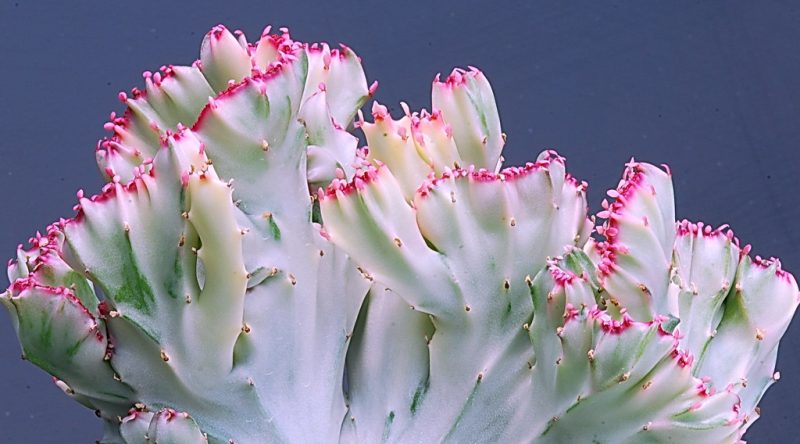
Euphorbia, commonly known as spurge, encompasses a vast range of flowering plants that excel in sunny locations. Characterized by their unique flower structures, many euphorbia species feature striking bracts that add boldness and visual interest to gardens. The variety of sizes and shapes in this genus means there’s a euphorbia suitable for every garden style.
Most euphorbias thrive in well-drained soils, and they’re particularly resistant to drought conditions, making them low-maintenance options for sunny spaces. Many euphorbias bloom in late spring or early summer, showcasing captivating colors that can range from greens to yellows and reds.
However, caution is advised when handling some euphorbia species due to their milky sap, which can irritate skin. Planting euphorbias in mixed borders can enhance both texture and color, and pairing them with other sun-loving plants creates diverse and enriching garden landscapes.
Fan Flower

Fan flower (Scaevola aemula) is a delightful perennial traditionally utilized in sunny gardens. Known for its unique fan-shaped blossoms that bloom in blue, purple, or white, this plant offers a relaxed and cheerful look that cascades beautifully from containers or hanging baskets.
Fan flowers thrive in hot, sunny environments and are exceptionally heat and drought tolerant once established. They prefer well-drained soil and bloom profusely from late spring to frost, creating vibrant displays. Not only does Scaevola add color to your garden, it also attracts pollinators, including bees and butterflies.
This versatile plant can be used effectively in containers, hanging baskets, and garden beds to provide low-maintenance color that thrives in tough conditions. With its lovely blooms and cascading growth, fan flowers enhance any garden, allowing for ease of care and stunning aesthetics.
Firecracker Plant
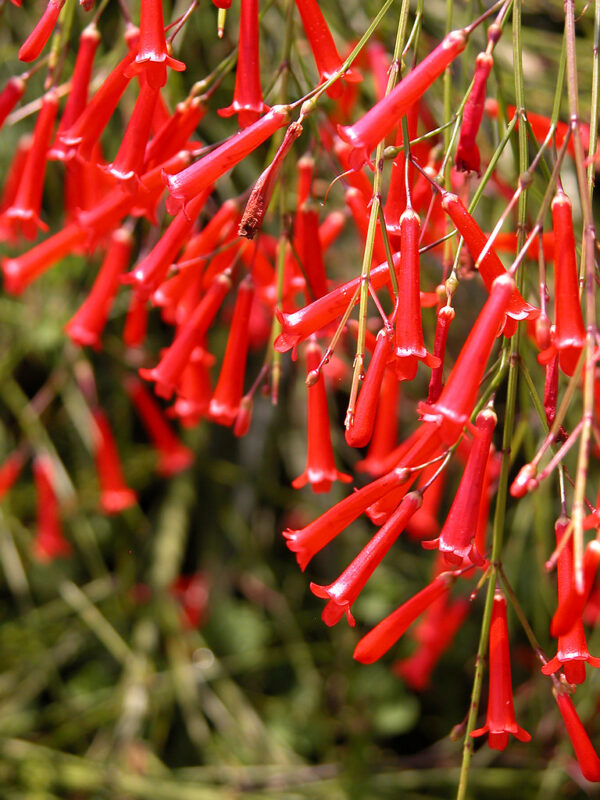
The Firecracker Plant (Russelia equisetiformis) truly lives up to its fiery name, producing long, tubular red flowers that burst forth like explosions of color. Thriving in full sun, this perennial is highly drought-tolerant and perfect for sunny gardens requiring minimal maintenance.
Firecracker plants prefer well-drained soils and bloom profusely throughout the summer, attracting hummingbirds and butterflies—perfect for creating a lively, dynamic garden. Their cascading habit makes them an excellent choice for hanging baskets, containers, or trailing over rock walls, ensuring visual interest from all angles.
With their vibrant blooms and long-lasting presence, Firecracker Plants enhance any sunny landscape, providing a beautiful focal point while attracting wildlife. They serve as a standout choice for gardens looking to incorporate bright colors and unique floral structures.
Geranium
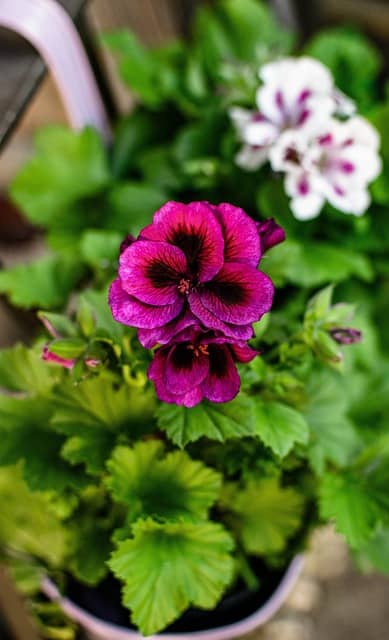
Geraniums are classics in sunny gardens, known for their cheerful flowers and robust growth. Available in a broad spectrum of colors, varying from pastels to bold hues, these perennial and annual varieties can be found blooming nearly year-round in many locales.
They thrive best in full sun and require well-drained soil for optimal growth. Geraniums are relatively low-maintenance once established, with their needs primarily revolving around regular watering during dry spells. Deadheading helps to promote new blooms throughout the growing season.
Ideal for borders, mass plantings, and containers, geraniums lend a vibrant charm to outdoor spaces. The attractive foliage can also provide interest, making geraniums a versatile choice for layering planting design. With their long-lasting blooms and colorful personality, geraniums universally appeal to gardeners.
Globe Amaranth
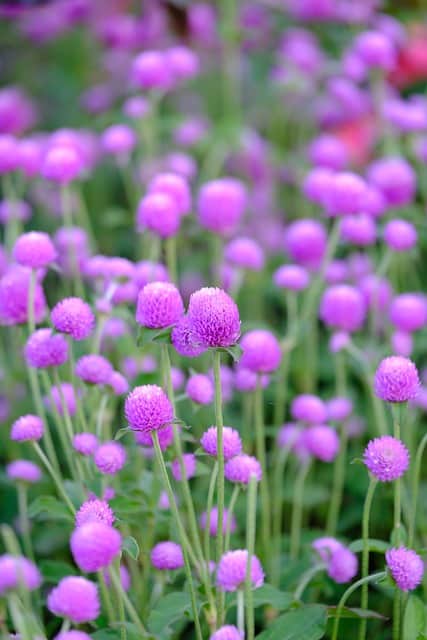
Globe Amaranth (Gomphrena globosa) adds a sensational touch to any garden with its unique, globe-like flowers and captivating colors. Known for its vibrant blooms available in shades of pink, purple, and orange, this drought-resistant annual thrives in hot, sunny conditions.
Globe amaranth prefers well-drained soil and can be planted in various garden settings, including borders, containers, and cutting gardens. Blooming from early summer until the frost, these flowers provide a charming addition to any sunny space and are excellent for bouquets, as they dry remarkably well without losing their shape.
With their low-maintenance nature, globe amaranth makes gardening effortless while still delivering colorful and joyful displays all season long. Their unique structure and hardiness ensure that gardeners will enjoy vivid blooms and their lasting beauty.
Hibiscus
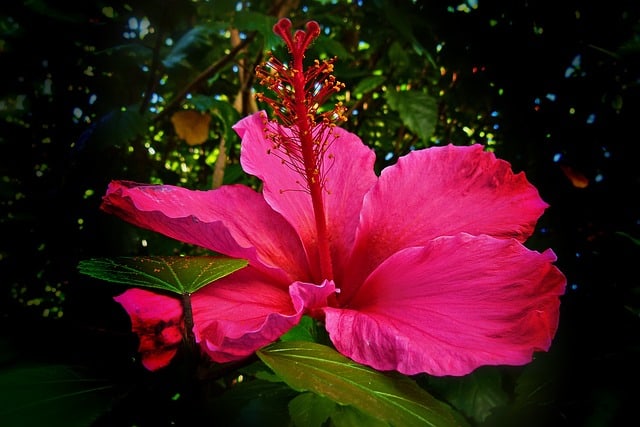
Tropical hibiscus is synonymous with summer splendor, offering huge, eye-catching flowers that can transform a garden into a tropical paradise. These iconic flowers thrive in full sun and prefer well-drained soils, making them perfect for sunny locales.
Hibiscus blooms come in a wonderful array of colors and sizes; their large, dramatic flowers bloom from mid-summer to fall. They require regular watering and fertilization for optimal growth and flowering. While they may be considered a bit high-maintenance initially, the bounty of blooms these plants provide is absolutely worth the effort.
Not only do they bring stunning visual appeal to garden spaces, but hibiscus also attracts pollinators, including hummingbirds, butterflies, and bees. Plant tropical hibiscus as focal points in borders or as part of a cottage-style garden, and watch your outdoor space burst with color and life.
Lantana

Lantana is a versatile perennial plant that can bring vivid color and vitality to sunny gardens. With its clusters of small, bright flowers that change color as they mature, lantana creates a captivating display.
This plant thrives in full sun and well-drained soil, showcasing impressive heat and drought tolerance. Blooming continuously from summer to fall, lantana attracts butterflies and other pollinators, enhancing the biodiversity of your garden.
Ideal for borders, hanging baskets, and as ground cover, lantana also works well in more formal arrangements or on slopes where erosion control is necessary. Its long blooming season and adaptability make lantana a fantastic choice for providing vibrant color with minimal effort.
Marigold
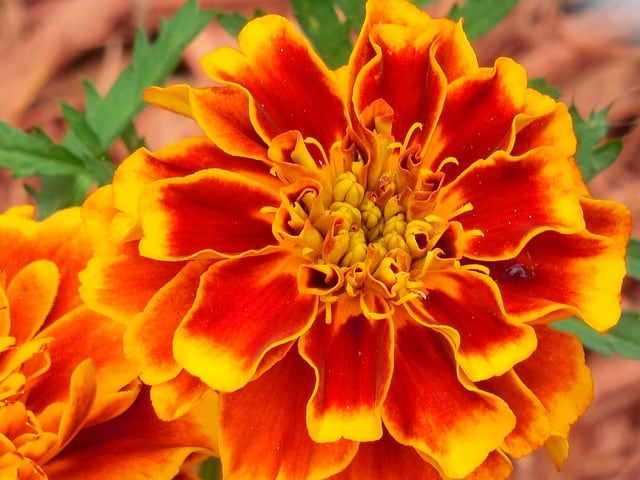
Marigolds are a gardener’s favorite, known for their warm, sunny colors ranging from yellows to rich oranges. This annual thrives in full sun and is exceptionally easy to grow, making it a staple in gardens around the world.
Marigolds bloom profusely throughout the growing season, providing cheerful bursts of color and attracting beneficial insects while deterring some pests, including aphids and nematodes. Preferring well-drained soil, they thrive with regular watering, particularly in dry conditions.
These flowers add beauty and charm to garden beds, borders, and containers. Their versatility allows them to blend seamlessly with other plants or stand out as a solo showpiece. Additionally, marigolds make excellent cut flowers, offering a sunny disposition indoors as well. With their resilience and vibrant color, marigolds create a joyful atmosphere in any outdoor space.
Million Bells
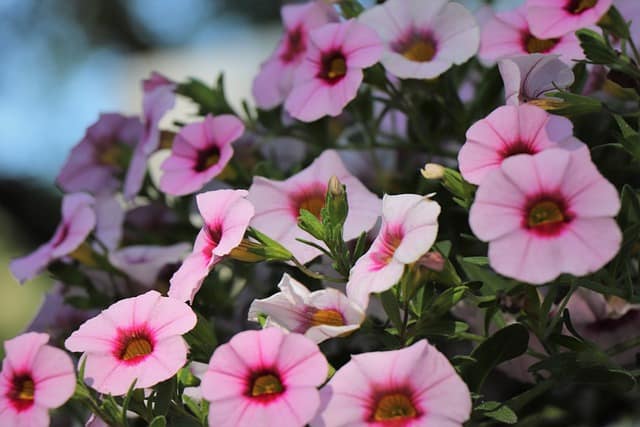
Million Bells (Calibrachoa) is a stunning addition to sunny gardens, admired for its sprawling growth habit and profusion of mini petunia-like flowers. These vibrant blooms are available in an enchanting range of colors, creating a captivating display in containers and hanging baskets.
Thriving in full sun, Million Bells prefer well-drained soil and require regular watering to maintain their vigorous growth. Blooming continuously from spring until frost, Million Bells create a trail of color wherever they are planted, providing a cheerful presence.
With their low-maintenance nature and abundant flowering, Million Bells are perfect for busy gardeners looking to add overflowing beauty to their outdoor spaces. Their cascading growth makes them ideal for hanging arrangements, ensuring that beauty can be enjoyed from above and below.
Pansy
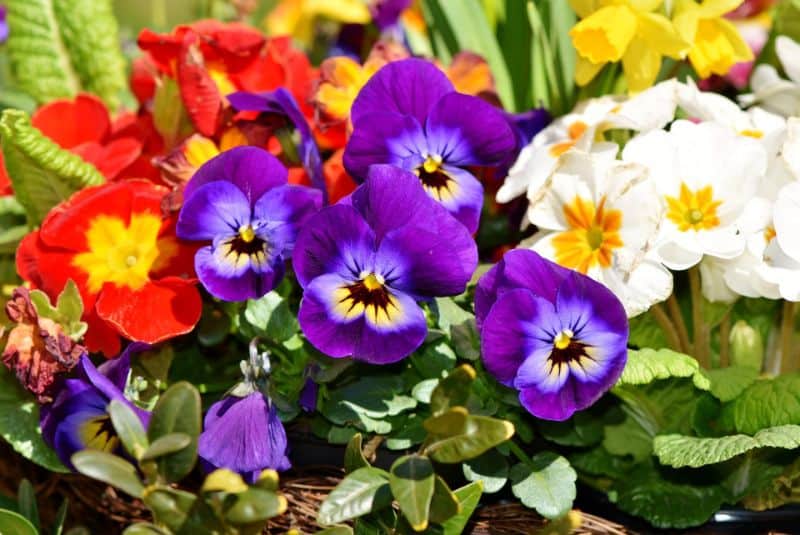
Pansies are cherished for their vibrant blooms and charming faces, offering a splash of color to gardens in early spring and autumn. These cool-weather-loving flowering plants are perfect for sunny spots but can also tolerate light shade.
With a wide variety of colors and patterns available, pansies bring character and whimsy to containers, beds, and borders. They thrive in well-drained soil and require regular watering to maintain their stunning blooms.
Pansies are excellent choices for springtime planting and can even be enjoyed throughout fall, creating long-lasting seasonal beauty. Their versatility, hardiness, and attractive presence make them beloved by gardeners and an essential addition to any sunny garden.
Pentas
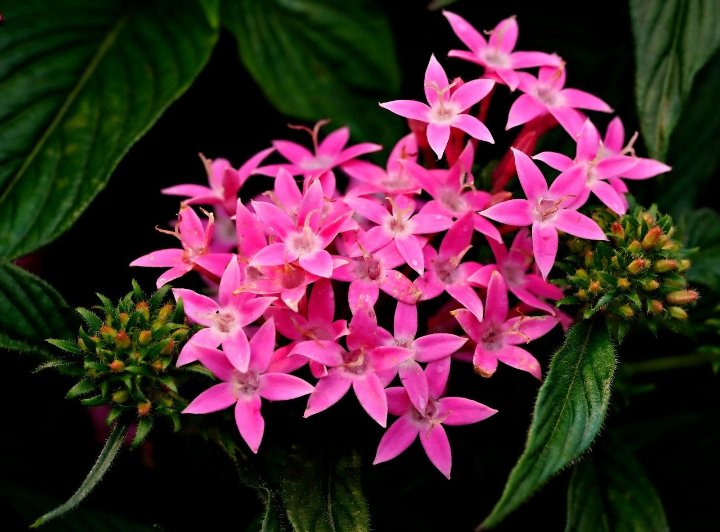
Pentas are eye-catching star-shaped flowers that thrive in full, direct sunlight. Known for their vibrant hues of red, pink, and white, these flowers attract butterflies and hummingbirds, creating a lively atmosphere in the garden.
Pentas prefer well-draining soil and are tolerant of brief dry spells once established. With blooms that appear in clusters, they thrive throughout the summer and can even continue blooming into early fall. This heat-loving perennial is perfect for mixed beds, borders, or containers, providing a long-lasting burst of color.
Their appealing growth habit makes them suitable for both formal and informal gardens, while their ability to thrive in hotter climates promotes stunning displays aligned with summer festivities. Pentas are an excellent choice for those looking to create vibrant pollinator gardens buzzing with activity.
Peony

Peonies are enchanting perennial flowers known for their lush, large blooms and captivating fragrance. Available in multiple colors, including soft pastels, vibrant pinks, and creamy whites, peonies add a touch of elegance and romance to any garden.
Thriving best in full sun with well-drained soil, peonies require minimal maintenance once established. They bloom in late spring or early summer, offering a spectacular display that attracts pollinators. Becoming a beloved staple in many gardens, peonies are suitable for cutting gardens, border plantings, and as eye-catching specimens.
Regularly watering them during dry spells and cutting back their spent foliage in the fall promotes active flower production for years to come. With their rich beauty and long lifespan, peonies are a timeless addition, cherished by gardeners of all skill levels.
Petunia
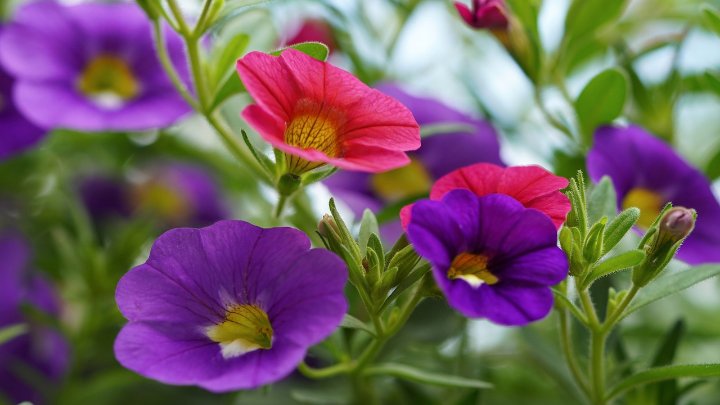
Petunias are a staple for sunny summer gardens, known for their abundant blooms that come in an array of colors and forms. From ruffled varieties to trailing cultivars, petunias can be found adorning borders, beds, and hanging baskets.
These sun-loving annuals thrive in well-drained soil and enjoy ample moisture, making consistent watering essential for vibrant growth. Petunias bloom continuously throughout the summer, bringing joy and color to outdoor spaces.
As versatile garden favorites, petunias can work wonders as borders or as part of a mixed display in containers. Their sweet scent further endears them to bees and butterflies, enhancing the garden’s ecosystem. Their ability to effectively cover soil and add overflow to garden designs makes them essential for any flower garden.
Red Poppy
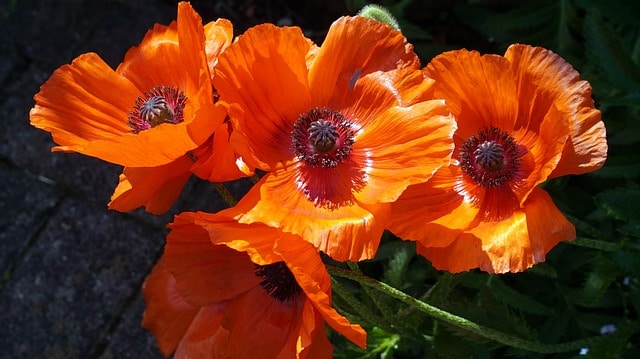
The iconic red poppy (Papaver rhoeas) is a striking flower that holds significant cultural importance and beauty. Known for its delicate and swirling petals, the red poppy flourishes in sunny gardens, providing vibrant visual interest.
These annual flowers thrive in well-drained soil and full sun, blooming beautifully from late spring to early summer. While they have a short bloom period, the sheer brilliance of their flowers is captivating.
Beyond their beauty, red poppies often symbolize peace and remembrance, making them meaningful additions to gardens. Their simple elegance and ease of care make them a favorite for those seeking to create enchanting outdoor spaces filled with history and grace.
Roses
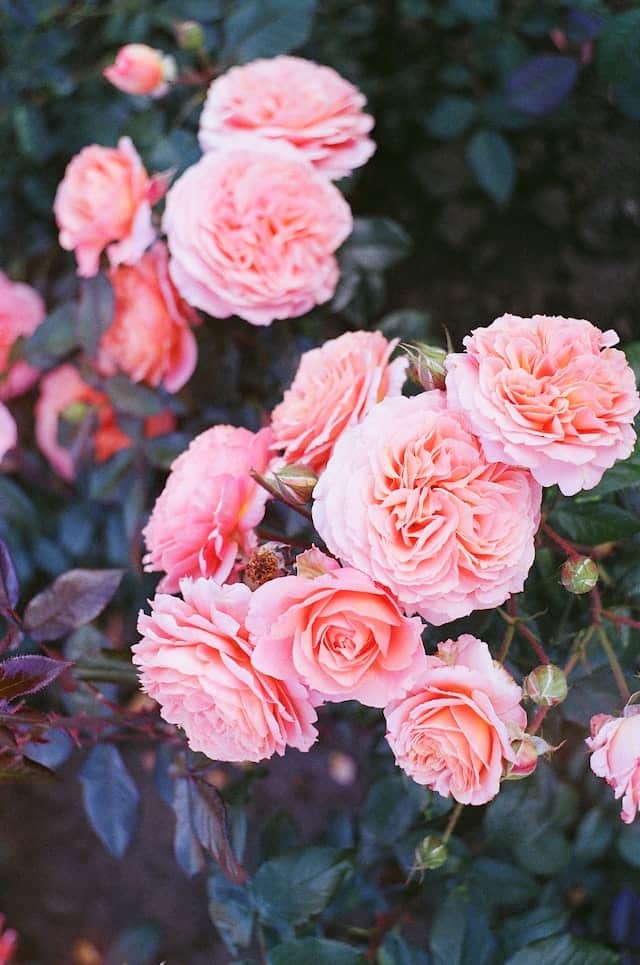
Roses are perhaps the most renowned flowers in the world, celebrated for their stunning blooms and intoxicating fragrance. Thriving in full sun, these beloved perennials come in a vast array of colors, shapes, and sizes—from traditional hybrid teas to climbing varieties—each offering unique charm to the garden.
Roses prefer well-drained soil and benefit from regular watering, especially during dry spells. Routine maintenance, including pruning and feeding, is essential to encourage prolific blooming and healthy growth. Thriving from spring until the first frost, roses create cherished memories with lasting beauty.
Their timeless elegance allows roses to shine in various garden settings, including formal gardens, cottage gardens, and even mixed borders. With their captivating presence and meaning across cultures, roses bring joy to gardeners and those lucky enough to receive them as gifts.
Portulaca
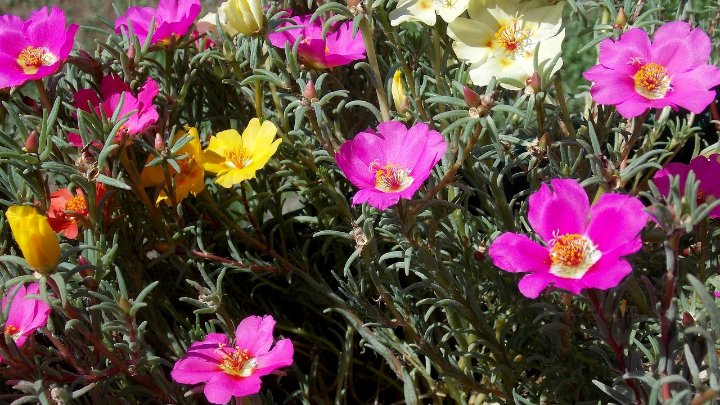
Portulaca, commonly known as moss rose, is a drought-tolerant succulent that thrives in sunny gardens. Known for their vibrant colors, including shades of red, orange, yellow, and white, these low-growing annuals create beautiful, cascading displays that can effectively fill in garden spaces.
Preferring well-drained soils, portulaca thrives in hot, sunny conditions and requires little maintenance. Their brightly colored flowers bloom from late spring to fall, and they can tolerate periods of drought, making them perfect for busy gardeners.
These plants are excellent choices for container gardens, rock gardens, and as ground cover in sunny locations. They lend an informal charm to garden beds and can even thrive in marginal soils. With their ability to flourish in challenging conditions, portulaca honors the beauty of resilience and adaptability.
Russian Sage
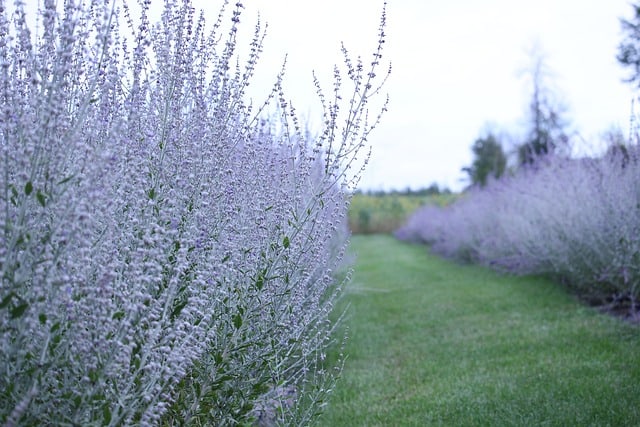
Russian Sage (Perovskia atriplicifolia) is a captivating perennial known for its silvery foliage and floral spikes adorned with delicate lavender-blue flowers. This robust plant thrives in sunny locations and well-draining soils, making it a versatile choice for gardens.
Russian Sage blooms from mid-summer to fall, attracting a range of pollinators, including bees and butterflies. It requires minimal care once established, giving gardeners a low-maintenance option for producing a visually striking landscape.
This drought-tolerant plant can be employed in borders, rock gardens, or used as a hedging option due to its height and density. With its captivating color palette and graceful form, Russian Sage becomes an adorable partner in sunny perennial gardens, combining beauty with ecology.
Salvia
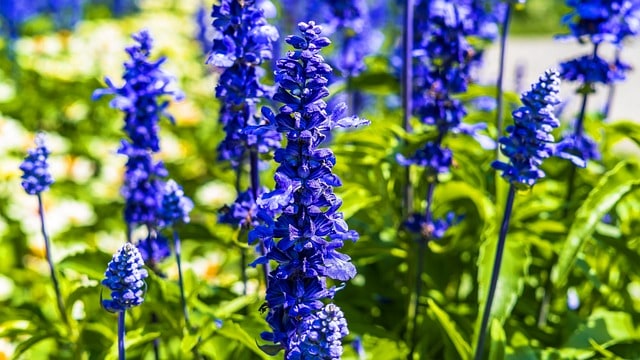
Salvia, or sage, encompasses a range of flowering plants, many of which thrive in sunny conditions. Known for their vibrant flower spikes, salvias are available in various colors, including shades of blue, purple, and red.
Salvias flourish in well-drained soils, attracting pollinators, hummingbirds, and beneficial insects. Their drought-resistant nature makes them an ideal low-maintenance choice for sunny gardens. Blooming throughout the summer and into early fall, these flowers add unparalleled charm and interest to garden spaces.
With their diverse appearances, salvias can fit into modern designs, cottage gardens, or whimsical settings. Planting salvias in groups not only enhances visual impact but also creates vital habitats for local wildlife. Their beauty and utility make them an essential component of pollinator gardens.
Shasta Daisy
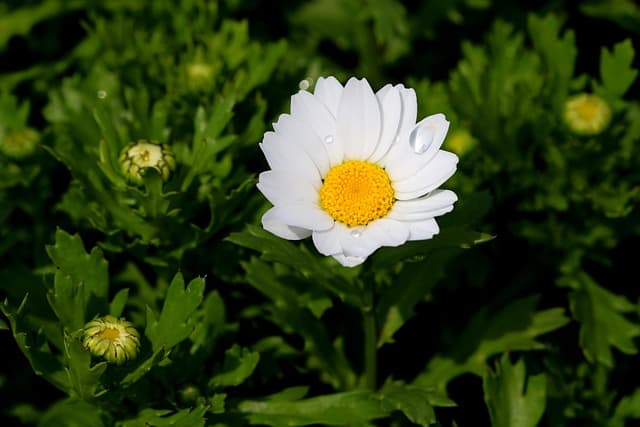
The Shasta Daisy (Leucanthemum x superbum) is a timeless classic known for its bright white petals and sunny yellow centers. These cheerful perennials thrive in full sun and well-drained soil, making them ideal for sunny gardens.
Shasta daisies bloom from late spring through the fall, adding continuous color and attracting pollinators like butterflies and bees. Low-maintenance and adaptable, they can thrive in various garden styles—formal, cottage, or wildflower gardens alike.
Deadheading spent flowers encourages longer blooming periods while allowing some seed heads to remain can benefit local wildlife during the winter months. Their strong stems and ability to create stunning drifts of color make Shasta daisies a staple in perennial gardens.
Snapdragon
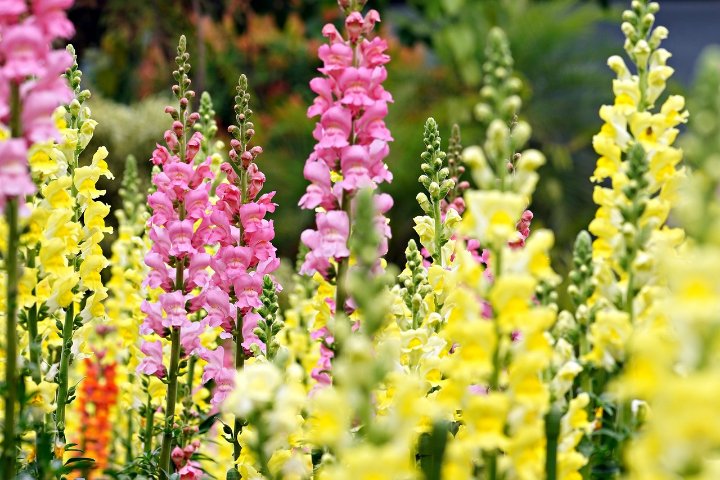
Snapdragons (Antirrhinum majus) are whimsical flowers that bring unique form and color to sunny garden spaces. Available in various sizes and colors, their tubular blooms resemble whimsical creatures, opening and closing when gently squeezed.
These biennials or perennial plants thrive in full sun and prefer slightly cooler weather, making early spring planting ideal for producing vibrant flowers. Snapdragons bloom from spring to fall, adding both height and interest to borders and containers.
Regular deadheading promotes extended blooming and healthy growth. Snapdragons are great choices for mixed borders and cutting gardens, offering cheerful bouquets throughout the season. Their playful presence adds charm and a sense of fun to any garden layout.
SunPatiens
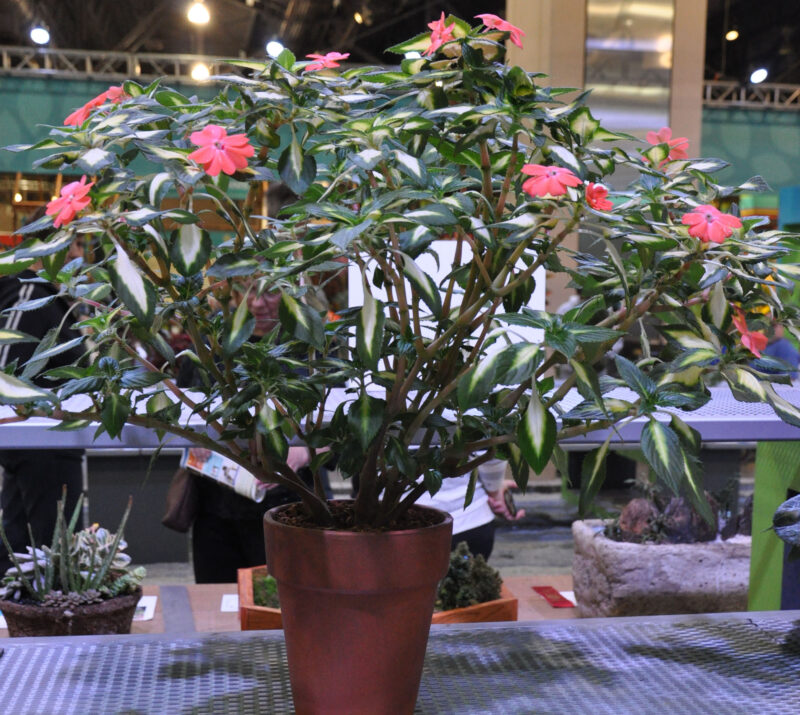
SunPatiens is a hybrid variety of impatiens that thrives in full sun, proving to be a game-changer for those who love colorful blooms but struggle with typical impatiens in hot, direct sunlight. With a robust growth habit and a wide variety of colors, SunPatiens are perfect for sunny spots in mixed beds, borders, or even hanging baskets.
These annuals favor well-drained soil and require adequate watering, particularly during dry spells. Their impressive blooming period lasts from late spring until frost, providing continuous color and liveliness.
SunPatiens not only resist powdery mildew but they also thrive in various garden designs, allowing for creativity in planting combinations. Their vibrant appearance and ease of maintenance make them a favorite among gardeners looking to enliven their sunny spaces effortlessly.
Sunflower
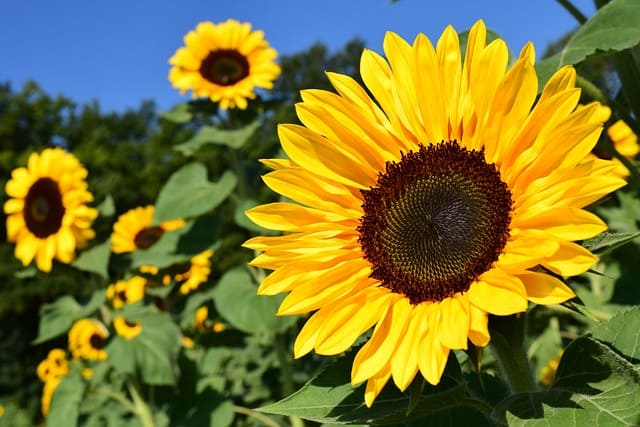
Sunflowers (Helianthus annuus) are the quintessential symbol of summer, embodying brightness and joy. Known for their towering height and large, cheerful blooms, sunflowers thrive in full sun and well-drained soil, making them perfect for sunny locations.
These annuals bloom from summer to early fall, turning their large flower heads to follow the sun—a behavior known as heliotropism. Sunflowers attract bees, birds, and other pollinators, contributing to the ecological health of your garden.
They can be used in traditional gardens or as part of larger summer festivities. Sunflowers also produce edible seeds, which can be harvestable for snacks or planting next season. Their cheerful disposition provides not only beauty but also abundance and sustenance, making them a staple for every sunny garden.
Verbena
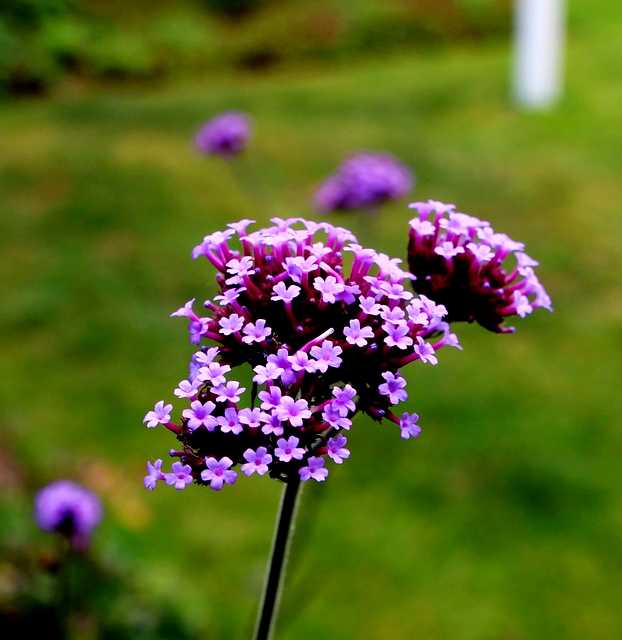
Verbena is a versatile flowering plant that thrives in sunny environments, producing clusters of tiny blooms in various colors, including purples, pinks, and whites. As an annual or perennial, depending on the species, verbena is appreciated for its ability to thrive in heat and its charm in the garden.
Verbena prefers well-draining soil and performs best with regular watering, especially during bloom periods. This low-maintenance flower continues to bloom from spring through fall, attracting butterflies and creating a lively garden atmosphere.
Ideal for borders, hanging baskets, or ground cover, verbena provides soft color and texture while spreading easily into adjacent spaces. Its long bloom period and low care requirements make it an excellent choice for busy gardeners looking to amp up the color and vibrancy of their sunny gardens.
Madagascar Periwinkle (Vinca)
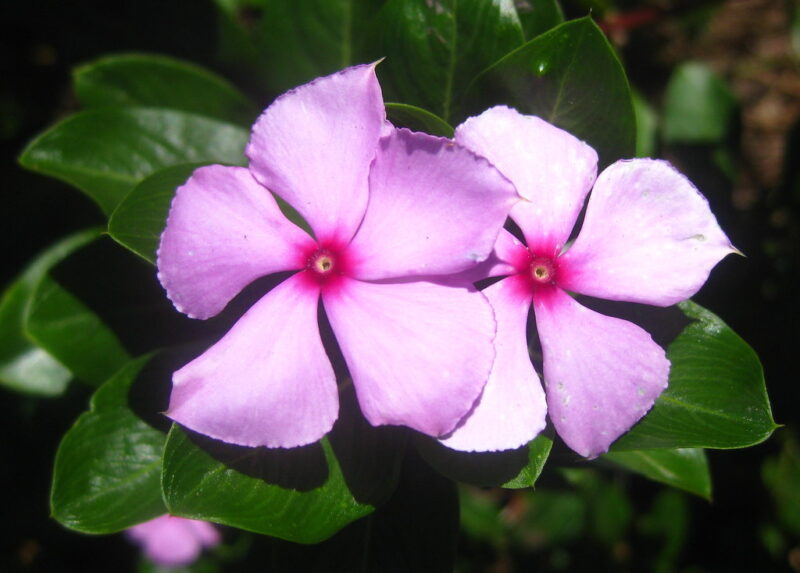
Madagascar Periwinkle (Catharanthus roseus) is a delightful and hardy annual preferred for sunny areas and well-drained soil. Known for their glossy green leaves and vibrant blooms in shades of pink, purple, and white, these plants create cheerful displays.
Moderately drought-tolerant once established, periwinkles thrive in hot, sunny environments and require minimal care. Blooming throughout the summer and even into fall, they work beautifully in containers, hanging baskets, and mixed borders.
Madagascar periwinkles handle hot summers with ease, making them an ideal choice for low-maintenance gardens. Their lovely colors and ability to continually bloom throughout the warmth create gardens filled with personality and charm.
Yarrow

Yarrow (Achillea millefolium) is a hardworking perennial that flourishes in sunny gardens, sporting feathery foliage and round clusters of small blooms in yellow, white, or pink. Known for its resilience and hardiness, yarrow thrives in well-drained soil and is drought-resistant once established.
Blooming from late spring through the summer, yarrow attracts a variety of pollinators, making it an essential plant for promoting biodiversity. It also has a unique quality of self-seeding, allowing it to create naturalized areas or spread throughout your garden.
Yarrow’s medicinal properties have been valued for centuries, making it not only a versatile flower but also a historically significant plant. With their long-lasting blooms and ability to thrive in tough conditions, yarrow adds beauty and utility to sunny landscapes.
Zinnia
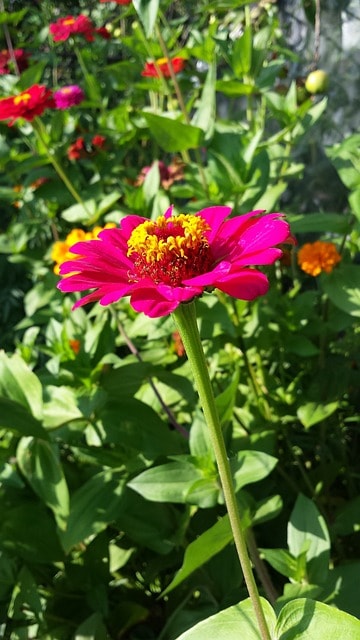
Zinnias are beloved annual flowers known for their vibrant and colorful blooms that can light up any sunny garden. Available in various shapes and sizes, zinnias bloom throughout the summer and into early fall, offering a joyful burst of colors including bright pinks, yellows, reds, and whites.
These flowers thrive in well-drained soil and are sun-loving, requiring full sun for optimal growth. They attract butterflies and other pollinators, creating a lively garden atmosphere while offering wonderful options for cutting flowers for arrangements and bouquets.
Zinnias are relatively easy to grow, making them suitable for novice gardeners seeking to create stunning displays without excessive effort. With their cheerful blooms and versatility, zinnias are an essential component in any garden celebrating the beauty of full sun flowers.


